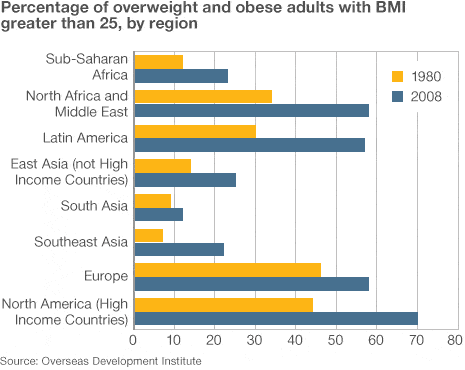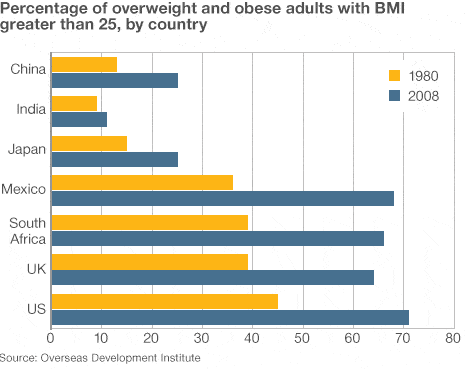The world is changing awfully fast, and with change expect many paradigms to shift or crumble entirely to dust. Over the course of a mere couple of decades, world’s politics has changed dramatically. Superpowers have fallen, the Cold War is well behind us and countries which not long ago were considered hallmarks of poverty have significantly changed their status. I sincerely recommend you watch some of Hans Rosling’s TED talks on the subject (he has a couple of extremely insightful keynotes).
The gist of Rosling’s talks concerns debunking myths about the developing world. People still have outdated, at times far fetched, impressions of how life in such countries as Vietnam, China or India is like. The truth is, these countries are catching up with the affluent west, and with these countries, their population is also experiencing the growth that comes with increased wealth. A new report released by the Overseas Development Institute claims that since 1980 the number of overweight and obese adults in the developing world as quadrupled, rounding the whole figure at 1 billion. Overall, in the whole world, one in every three people is overweight or obese. The percentage of adults classed as overweight obese has increased from 23% to 34% between 1980 and 2008.
The developing world is catching up, but it’s picking up bad habits too
The saddening figures are aimed at policy makers, in hope that better health plans may be introduced at a national level. The figures become even more disheartening when we take into account that most of the obesity growth comes from developing countries like Egypt or Mexico. Countries like the US or UK are, of course, at the top of the obesity chain in the world, however developing countries severely lack the necessary infrastructure to battle obesity and, moreover, local governments show that they have learned nothing from developed countries and their fight against obesity which has been going on for decades.
The report, titled Future Diets, suggests that the 904 million people in developing countries now classed as overweight or above (BMI of more than 25) have grown in this startling number due to a dietary shift from mainly cereals and grains to more fats, sugar, oils and animal products.
[READ] Sugar, not fat, the main culprit behind the obesity ‘epidemic’
The greatest growth in overweight people occurred in south east Asia, where the percentage tripled from a lower starting point of 7% to 22% since 1980. On a country level, China and Mexico experienced the greatest obesity growths, as overweight and obesity rates had almost doubled.
The report, as others before it, pin the fattening of the world on increased wealth. Particularly, the rapid growth of the middle class in the developing world definitely shows its mark.
“People with higher incomes have the ability to choose the kind of foods they want. Changes in lifestyle, the increasing availability of processed foods, advertising, media influences… have all led to dietary changes,” writes one of the report authors, Steve Wiggins, for BBC.
Why the world is becoming overweight
The actual mechanics that contribute to obesity are a bit complicated. During my research, however, I came across a most helpful piece written by Daniel Hoffman, a research fellow at the New York Obesity Research Center. Hoffman outlines a few key factors that lead to the rapid fattening of the world’s population including: urbanization (a tremendous amount of people have migrated towards the city in the past thirty years), diets (resulting from urbanization and wealth), lack of physical activity (a worldwide sedentarism), early life malnutrition (making people predisposed to becoming overweight when food is plentiful) and even genetics.
[RELATED] Find out how much the entire world’s population weighs
What can be done? The Future Diets report author offer South Korea as an example where efforts to preserve the country’s traditional diet have included public campaigns and large-scale meal preparation training for women. Clearly, a combination of education (good calories/bad calories) and good policy making is in order. How many people would be willing to pay a tax on fatty foods, though? What about big junk food lobbyists? In the U.S., things are getting desperate, as people are becoming overweight in an increasing proportion and at an ever earlier age. It’s no wonder, considering 90% of the food endorsed by professional athletes is junk food! People are kept in the dark about their health, and apparently there are good reasons, for some, to maintain the status quo.
“We need to act urgently to deal with the scandal of millions of cases of extreme hunger and under-nutrition in children, but we also need to think what happens if we provide lots of extra calories, containing few vitamins, and encourage excess consumption,” said Alan Dangour, a reader in food and nutritional global health at the London School of Hygiene and Tropical Medicine.
“Clever, joined-up policies are needed.”












